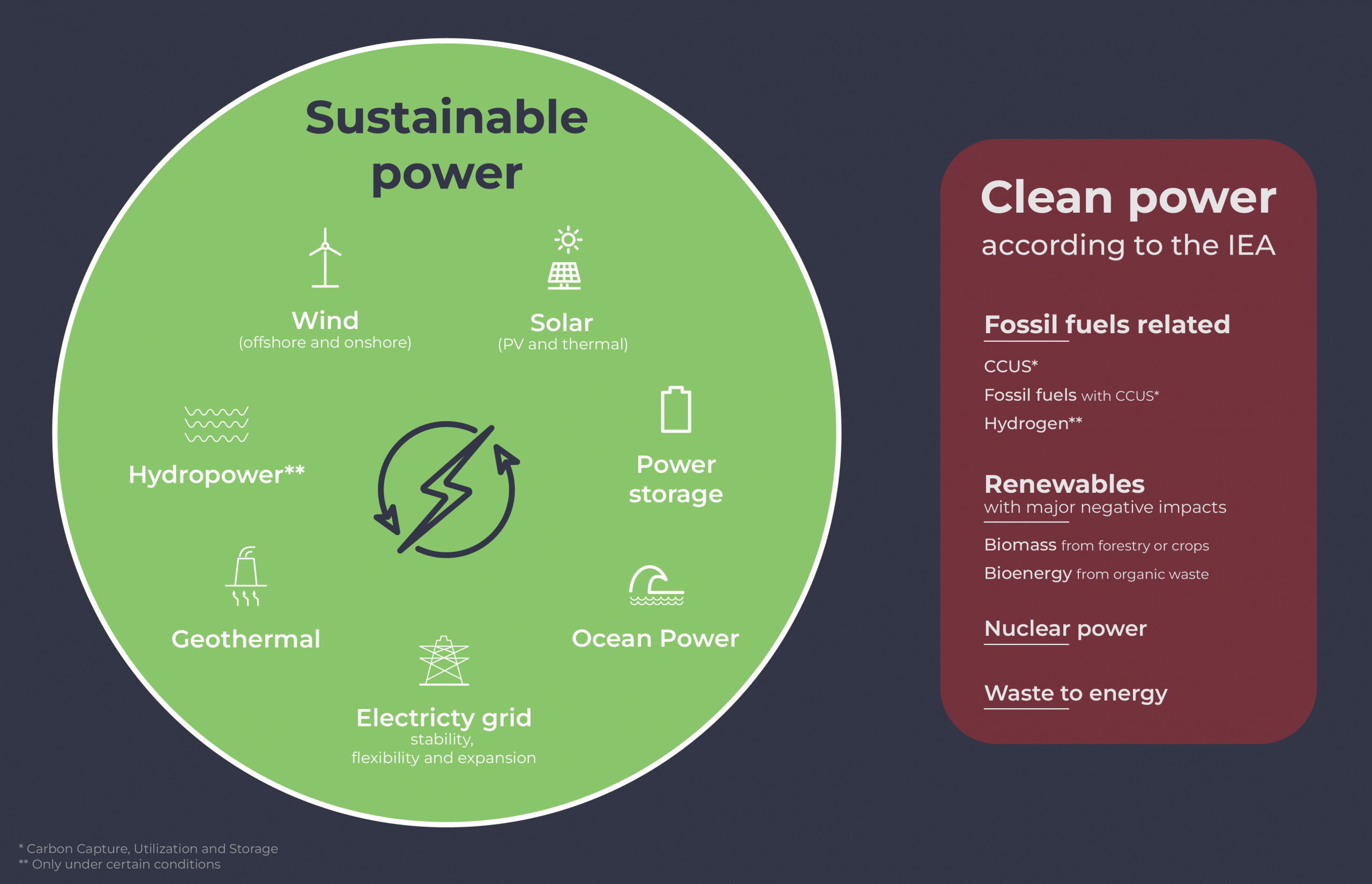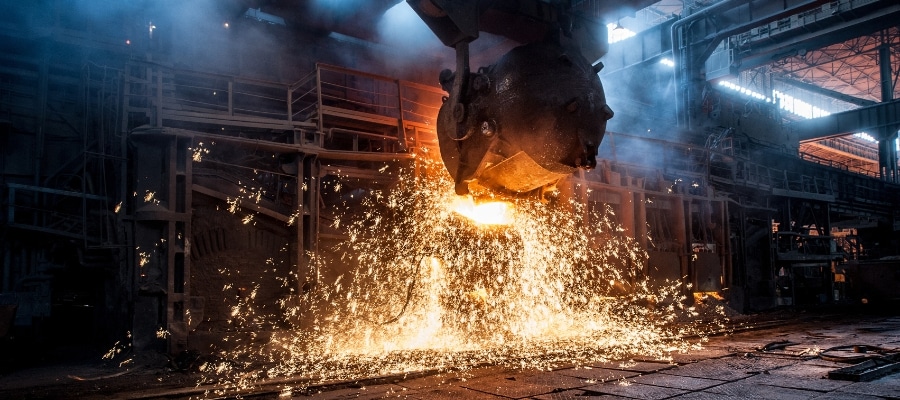Limiting global warming to 1.5°C requires massive investments in the energy transition. According to the International Energy Agency (IEA) and its “Net Zero Emission by 2050” (NZE) scenario [1], annual investments in “clean energy” must increase 2.5-fold by 2030, compared to 2023 estimation. But there is no such thing as “clean” energy, all energy sources inherently exert an environmental and societal influence. Though it is an important aspect, being renewable or with low GHG emissions is not enough. A rapid and just transition involves adopting a comprehensive perspective and directing investments toward sustainable solutions, with minimal impact on communities and ecosystems. Reclaim Finance sets a brief overview of the energy sources and technologies included in the IEA clean energy scope and clarifies the frame of the quest for sustainable energies.

Read our technology factsheets:
“Low carbon” is not enough to be sustainable
IEA’s “clean energy” definition includes the following: fossil fuels with CCUS, hydrogen, nuclear, wind power, solar power, hydropower, marine power, geothermal, solid biomass, bioenergy, and waste-to-energy. Yet, some technologies incidentally extend the use of fossil fuels which are at the center of the issue, and several of them do have significative impact on communities and ecosystems and could create long-term severe damages if developed at a massive scale.
Carbon Capture Utilization and Storage (CCUS): a risky gamble to delay the transition away from fossil fuels
Sometimes described as a solution to decarbonize fossil power production by promoters of continued use of fossil fuels, CCUS technologies suffer from severe shortcomings. These includes significant costs that are likely underestimated [2], high energy consumption – such a system consumes 20 to 30% of the power plant’s energy – consequently increasing fossil fuel consumption, and insufficient capture performances making this technology unable to meet its promises when implemented. Moreover, while discussed for a long time, there are currently only two projects running worldwide and both have run below the promised capture rate and faced financial issues [3]. These projects illustrate how, when moving from paper to reality, CCUS fails to deliver on its potential benefit in a cost-effective manner: betting on this technology therefore adds uncertainty to our ability to reduce our CO2 emissions.
Hydrogen: an energy-intensive technology presently dependent on fossil fuels
Currently, hydrogen produced from fossil fuels – a highly carbon-intensive process – represents 81% of global production [4]. Even if coupled with CCUS, these production methods carry significant climate impacts. Hydrogen can only be sustainable if it is “green hydrogen”, i.e. produced from water electrolysis powered by sustainable sources and used for specific sectors. Electrolytic hydrogen requires high amounts of energy and currently represents a mere 0.04% of global production. It should thus be limited to non-electrifiable sectors and industries like steel and shipping, not residential heating nor power storage where more efficient alternatives are available to scale.
Nuclear power: the elephant in the room
Nuclear power is also not a sustainable solution for the energy transition due to the long lead times and massive investments required for the development of new nuclear capacities [5] which do not allow to act swiftly enough to achieve power decarbonation by 2040. Furthermore, with limited available uranium reserves [6], the global-scale development of nuclear energy appears to be irrelevant for long-term sustainability. [7]
Not all renewable energy sources are sustainable
Renewable energy sources with major negative impacts: the phony friend
- Solid biomass
Combustion of solid biomass (logs, wood chips or pellets) emits large quantities of CO2 – between 3% and 50% more CO2 than coal per unit of energy produced. Nevertheless, proponents of solid biomass claim climate benefits on the basis that carbon emissions from combustion are recovered as the trees grow back. However, it would take decades for this carbon to be potentially reabsorbed by forest growth. Scientists speak of the creation of a “carbon debt” that increases as more trees are cut down to produce bioenergy [8] and is incompatible with the need to reduce absolute carbon emissions in the short term. Moreover, there is no certainty that carbon reabsorption will take place since tree growth can be threatened by factors such as fires (whose risks and intensity are increased by global warming), poor forest management, land use competition, and others.
- Biogas and biofuels
Biogas and biofuels are produced largely from organic waste or crops that, at industrial scale, compete with agricultural land and damage natural ecosystems. Moreover, they can have lifecycle GHG intensities comparable to those of fossil fuels or even larger, making them a truly unsustainable energy source.
Sustainable energy sources to massively develop
- Solar, Wind, Ocean Power and Geothermal
Sustainable energy is produced by renewable sources with limited impacts on biodiversity and communities, and whose development is guided by robust human rights policies [9], such as the United Nations Guiding Principles on Human Rights (UNGPs) [10] or Free, Prior and Informed Consent (FPIC) [11]. These include solar (photovoltaic and thermal), wind (on and offshore), ocean power, and geothermal with low CO2 emissions. - Hydropower
To be sustainable, large-scale hydropower must respect the recommendations of the World Commission on Dams [12], and for small scale ones, certain precautions must be respected [13], depending on specific context of local biodiversity and communities. In any case, hydropower should not compromise existing efforts to restore watercourses and biodiversity. Regarding the European Union, most of Europe’s potential has aldready been harnessed, with significant negative impacts on ecosystems and biodiversity [14]. No new hydropower should be developed in the EU and financing aiming to increase hydropower capacity should be focused exclusively on refitting and upgrading of existing hydropower plants, where relevant.
Power transmission, storage, and distribution
Due to decentralized generation and intermittency of wind and solar notably, the expansion of sustainable power capacities will require the development of more flexible electricity grids [15] encompassing modernization – through refurbishment and new-build – of transmission and distribution infrastructures, battery storage and seasonal storage, as well as the development of stand-alone sustainable power solutions such as mini-grids for off-grid needs. It is therefore important not to omit massively financing these infrastructures.
In fact, several so-called “clean” energy sources and technologies are false solutions that divert investments away from truly sustainable solutions, and thus reduce our chances of effectively limiting global warming under 1.5°C. This is even more the case considering that in the NZE scenario, based on “clean” energy, global warming peaks at just over 1.5°C in 2050 and declines to about 1.4°C by 2100, with only a 50% probability due to scientific uncertainty.
To mitigate this risk, and while the IEA’s numeral targets are useful references for financial institutions to drive their policies, banks should focus their efforts on technologies with proven effectiveness and little impacts on ecosystems and communities, currently available for rapid and large-scale development. Technologies based on risky bets on the future are thus excluded from the scope of sustainable power.
For financial institutions, the priority is to embrace transparency, notably by disclosing a detailed inventory of the energy sources and technologies integrated in their energy transition financing. Reclaim Finance urges them to align with the sustainable power scope defined above and to make quantified financing commitments by 2030. These aspects are assessed in the Sustainable Power Policy Tracker [16].
Disclaimer: Reclaim Finance based this analysis on extensive research and is currently working on creating synthetic factsheets for each of the main sources and technologies discussed in this article. The links will be progressively added as they are published.



